_We may earn revenue from the products available on this page and participate in affiliate programs. Learn more ›
_
Best for Men

Crescent Moon Gold 10 Mens Backcountry
LEARN MORE
Summary
Crescent Moon’s largest aluminum snowshoe is made specifically for larger men, or those going in deep snow.
Best Overall
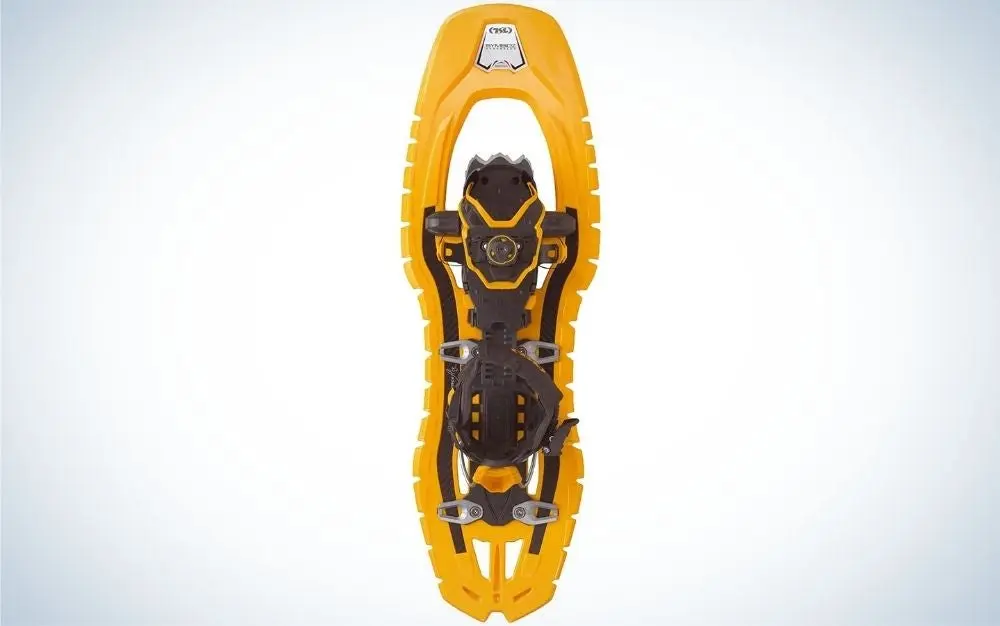
TSL Symbioz Hyperflex Adjust
LEARN MORE
Summary
The TSL Symbioz Hyperflex Adjust has the absolute best binding for comfort, ease, and sturdiness.
Best for Women
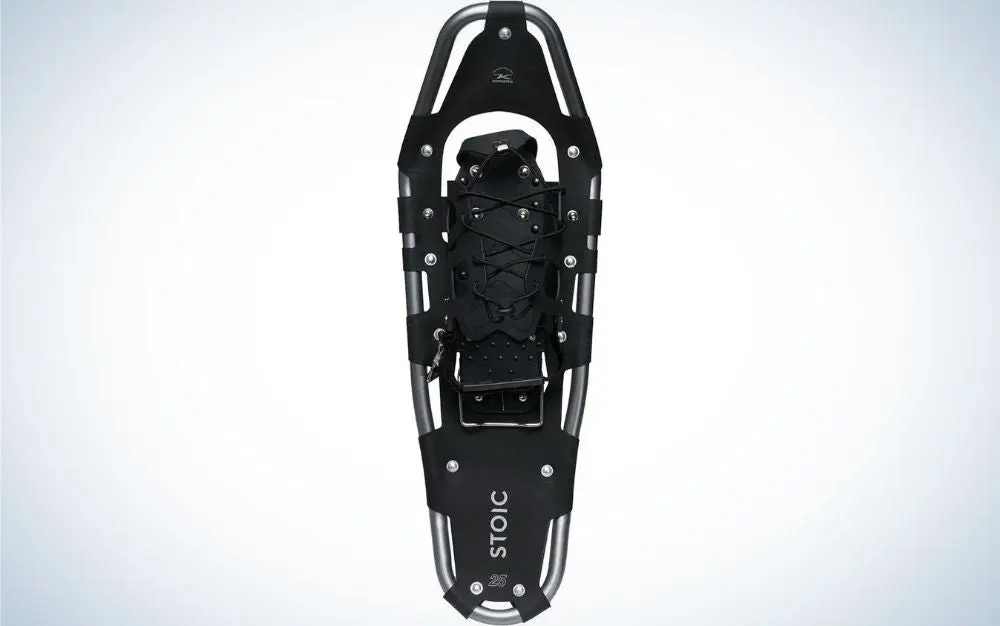
Stoic Snowshoes
LEARN MORE
Summary
The delicate, narrow shoe binding combined with the lightweight aluminum frame makes these snowshoes a great addition to your winter gear.
The best snowshoes will fit the needs of your activity and provide stability for your journey. Snowshoeing can be a quiet walk in the woods, a challenging climb up a peak, or a heart pounding run on a groomed trail. By choosing the right snowshoes, you’re ensuring you’ll have a safe, fun, and manageable day on the snow. Here are the things to consider to help you find the best snowshoes for your pursuit.
**Best Overall: TSL Symbioz Hyperflex Adjust
**
**Best for Hiking: MSR Evo Trail Snowshoes
**
**Best for Men: Crescent Moon Gold 10 Mens Backcountry Snowshoes
**
**Best for Women: Stoic Snowshoes
**
**Best for Beginners: Crescent Moon Eva Foam Snowshoes
**
**Best for Alpinists: Snowfoot Snowshoes
**
How We Chose The Best Snowshoes
As a dedicated New Hampshire winter recreationalist, I am no stranger to winter hiking, mountaineering, skiing, and snowshoeing. For this article, I chased every snowstorm to make sure these snowshoes were tested head-to-head in fresh powder, wet snow, ice, and packed trail. I also tried them on flat terrain, rolling hills, and even some of New Hampshire’s highest peaks. My experience teaching winter mountaineering, snowshoeing, and survival also play a significant role in my selection process. When looking for the best snowshoes, I evaluated the products using the following criteria:
Versatility: Most folks are looking to own one pair of snowshoes that can handle a variety of terrains and conditions. While there are snowshoes that specialize in one type of condition, it’s important to note that most should be versatile enough to handle a range of snow conditions.
Durability: I featured snowshoes that should last you decades. An affordable pair like Costco snowshoes can be a good choice if price is your main concern, but if you are looking for a purchase that will last you hundreds of miles, the MSR’s Evo snowshoes are a much better choice.
Comfort: Snowshoes can be cumbersome, tiring, and frustrating if they are the wrong size or type. Even with my years of experience, I only choose to use snowshoes if it’s absolutely the best choice for the terrain. As a result, I evaluated these snowshoes with a harsh eye. My picks provide more comfort and safety when out in the field.
The Best Snowshoes: Reviews & Recommendations
Best Overall: TSL Symbioz Hyperflex Adjust
Best Overall

TSL Symbioz Hyperflex Adjust TSL
Why It Made the Cut: With a flexible platform, strong traction, and easy and reliable binding, you’ll be psyched to take these in the snow.
Key Features
Weight per pair: 4 lbs 3 oz (size medium)
Length: 23.5 inches (size medium)
Materials: Composite
Pros
Easy BOA binding system
Flexible deck for natural stride
3 size options depending on user’s shoe size and weight
Cons
Expensive
The TSL Symbioz Hyperflex Adjust is an impressive piece of engineering. Made from TSL’s hyperflex technology, the deck is flexible—moving with your natural step as well as bending as you ascend up a trail. These snowshoes come in three sizes (small, medium, and large), depending on your weight and amount of floatation needed. The unique hourglass deck shape will make you rethink how you see snowshoes—they are flexible, comfortable, and move easily through snow.
The TSL Symbioz Hyperflex Adjust has the absolute best binding for comfort, ease, and sturdiness. The toe of your boot attaches using a BOA binding and the ankle with a padded plastic clip system. To close the BOA binding, simply twist a knob that tightens stainless steel wires. As a result, these bindings are easy to attach with a mittened hand, are comfortable, and will give you peace of mind that your boot won’t pop out.
The traction of these snowshoes is intense. Front teeth, vertical blades, and eight interchangeable stainless steel mountaineering crampons ensure you won’t slide on ice. If the teeth weren’t enough to ensure you’ll climb up a hill, these come with an easy-to-use heel lift. Simply raise or lower this lift to reduce calf fatigue and increase traction on steep slopes.
While the TSL Symbioz Hyperflex Adjust is my pick for the best snowshoes, it has its limitations. Its smaller size and ergonomic shape sacrifices surface area for comfort. While these will be your favorite tool for packed trails, hills, and peaks—its floatation is poorer than some of its competitors. It also comes at a high price point at around $300.
Best for Hiking: MSR Evo Trail Snowshoes
Best for Hiking
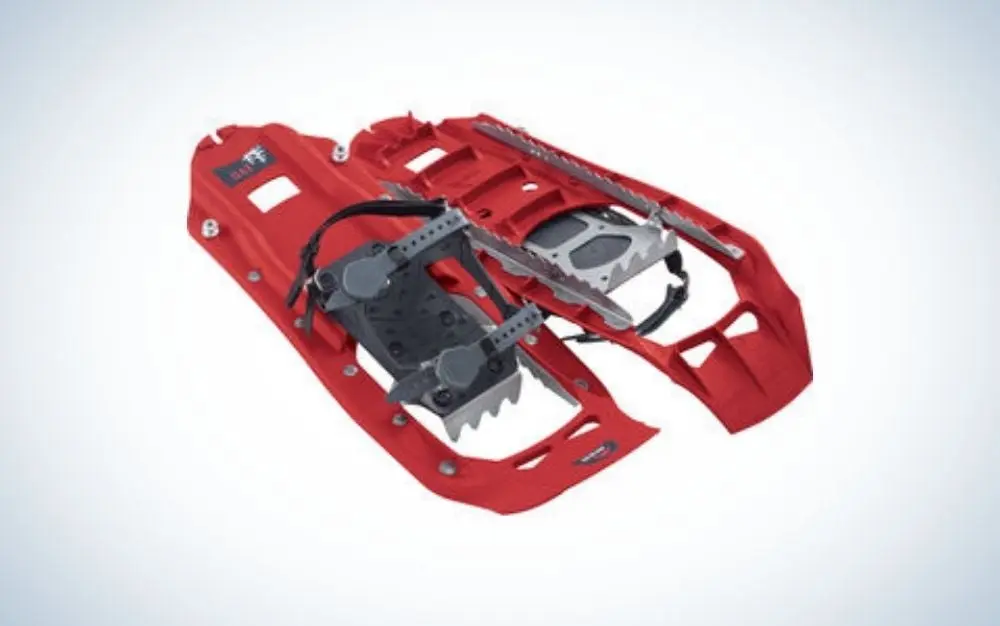
MSR Evo Trail Snowshoes Msrgear
Why It Made the Cut: Lightweight, excellent on a variety of terrain, and bindings that fit every type of boot makes the MSR Evo Trail Snowshoes the best snowshoes for hiking.
Key Features
Weight per pair: 3 lbs 9 oz
Length: 22 inches
Materials: Composite
Pros
Lightweight
Strong traction
Easy binding for assortment of footwear
Cons
Noisy
It’s easy to love these snowshoes. The MSR Evo is a lightweight composite snowshoe that will bind onto everything from a soft hiking boot to mountaineering boots. The composite plastic decking creates reliable surface area against the snow although it can be louder against groomed trails when hitting the surface.
I tested these snowshoes in every type of snow condition possible (fresh powder, packed snow, wet snow, and even ice), and they held up—every time. The bottom traction was impressive. Sharp toe crampons combined with side rail teeth allow the user to side-step along the trail and still have traction. The bottom is also equipped with breaking bars to prevent backsliding on slopes.
The MSR Evo binding has traditionally been rubber straps that can easily be adjusted, even when wearing gloves or mittens. However, MSR is changing their Evos to a new binding similar to their high performance MSR Lightning Ascent Snowshoe. I was able to test both the traditional Evo bindings side by side with the new ones to be released this year. Both systems are easy to use and versatile to a variety of footwear.
While the MSR Evo isn’t considered a budget snowshoe, at around $150, it provides high value for your dollar. Even though this is the best snowshoe for hiking, the MSR Evo isn’t for everyone. This unisex snowshoe max load is recommended at 180 lbs without the tail extensions (sold separately), and 250 lbs with the tails. Although I tested them with more weight than 180 lbs, heavier hikers will be more comfortable with a weight-friendly snowshoe like the Crescent Moon Gold 10 (featured below) or the Atlas Snowshoes which come in three sizes for up to 300 lbs.
Best for Men: Crescent Moon Gold 10 Mens Backcountry Snowshoes
Best for Men

Crescent Moon Gold 10 Mens Backcountry Snowshoes crescent moon snowshoes
Why It Made the Cut: Crescent Moon’s largest aluminum snowshoe is made specifically for larger men, or those going in deep snow.
Key Features
Weight per pair: 5 lbs 2 oz
Length: 32 inches
Materials: Aluminum frame with polyurethane fabric decking
Pros
Accommodates large shoes
Excellent floatation on powder
Can handle a heavy load
Cons
Heavy
This is one of the longest snowshoes in the industry. Made of lightweight aluminum tubing covered with polyurethane fabric, the deck stretches an impressive 32 x 10 inches, which is in some cases almost a foot longer than its competitors.
While you might think this long deck would get in the way, it is exactly what you’d need to maneuver through deep snowy forest. What’s more, the tapered design of the deck keeps the tails out of your way and allows this to be a great choice for hunters as well. Those hunting snowshoes hares
in dense woods will benefit from the agile nature of these snowshoes.
Traction is good on the Crescent Moon Gold 10’s. Crampons at the toe, ball, and heel of the foot provide reliable grip when maneuvering hills or icier conditions. The Gold 10’s come with optional heel lifts. This feature acts as a kind of high heel when ascending a steep trail. Climbing with a heel lift is usually more comfortable and improves traction against the incline.
Snowshoes sizing is a real concern for many men, especially when wearing bulky boots. The bindings of the Gold 10 have a larger front foot cage than their other snowshoes and is meant to accommodate oversize 10.5. Boots are secured in the cage with an adjustable strap.
While this is the best snowshoe for men based on the weight load, large bindings, and impressive floatation, they are not light nor short. This makes them a great snowshoe for a day in the woods, but not a great choice if you just need a “just in case pair” strapped to your pack. At almost 2 lbs heavier than the MSR Evos, they fall in the heavy category.
Best for Women: Stoic Snowshoes
Best for Women

Stoic Snowshoes Stoic
Why It Made the Cut: The delicate, narrow shoe binding combined with the lightweight aluminum frame makes these snowshoes a great addition to your winter gear.
Key Features
Weight per pair: 4 lbs
Length: 25 inches
Materials: Aluminum frame with heavy-duty hypalon decking
Pros
Comfortable binding
Excellent flotation
Heel lift for going uphill
Cons
Narrow binding won’t accommodate wide boots
Stoic fits the mold of a traditional aluminum snowshoe. The aluminum exterior tubing provides a lightweight frame that has excellent floatation on powder while remaining quiet throughout your walk.
Stainless steel crampons on the ball of the foot and heel provided reliable traction on slippery packed snow and while ascending hills. The heel was easy to lift and helped displace weight over the back teeth when climbing. However, I found the riser challenging to lower without taking my gloves off.
The binding system on the Stoic snowshoes was different from the other snowshoes I tested. The shoe slips into a soft, molded rubber that is then cinched down with a cord. While some bindings dig into your shoe or boot leaving bruising or rubbing areas, this is soft and flexible. I was concerned that it wouldn’t provide the support I needed to climb hills, but I didn’t have any issues. This means these snowshoes could be used with a soft shoe or winter boot, unlike many of the others that strap against a hard exterior of a boot.
The Stoic Snowshoes are unisex and come in sizes 22 in, 25 in, and 30 in depending on weight, which makes it easy to find the perfect size for your adventure. The limitation of this snowshoe is the binding. While it is great at accommodating street shoes and soft boots, the narrow rubber foot sleeve could not fit a mountaineering boot.
Best for Beginners: Crescent Moon Eva Foam Snowshoes
Best for Beginners
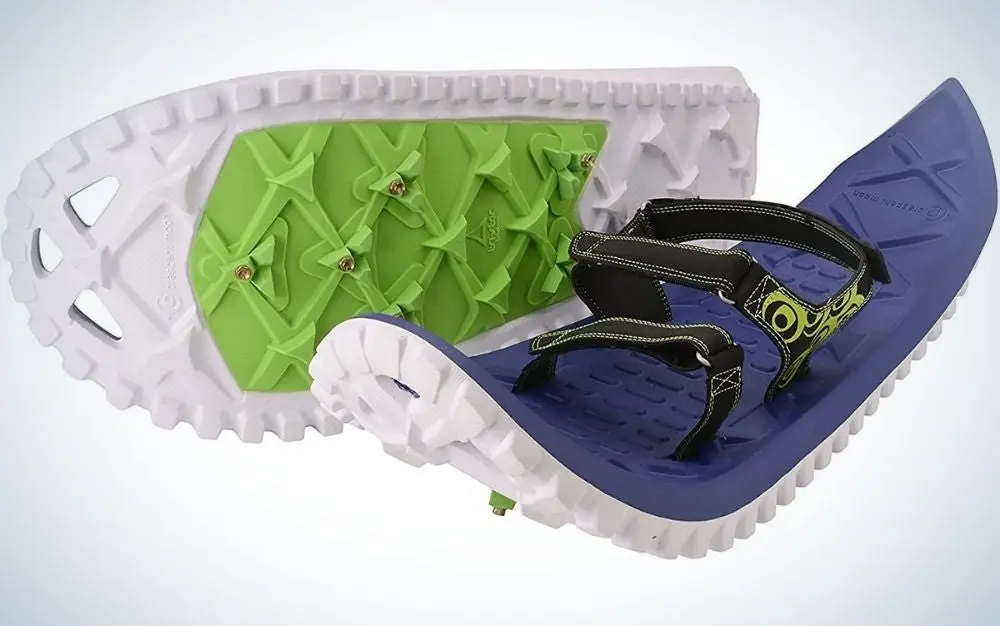
Crescent Moon Eva Foam Snowshoes CRESCENT MOON
Why It Made the Cut: The EVA Foam Snowshoe is a great starter to snowshoeing—comfy, quiet, and fun. These will make you want to play in the snow!
Key Features
Weight per pair: 3 lbs 8 ounces
Length: 24 inches
Materials: Ethylene Vinyl Acetate (EVA) Foam
Pros
Quiet
Easy to use
Comfortable
Cons
Weak traction
If you are a novice to snowshoeing and looking for a fun way to start exploring trails in winter, the Crescent Moon Eva Foam snowshoes are the best snowshoes for beginners. With no moving parts, this simple model has a thick, curved foam deck that insulates against the cold and provides a spongy cushion against the ground.
The bindings are simple fabric straps with velcro and unlike the previous picks, your boot heel does not lift from the decking when you walk. Essentially, it’s like having large shoe soles. The bottom of the Eva Foams has small ice spikes on to prevent sliding.
This snowshoe is perfect for groomed trails, walks on frozen lakes, ice fishing, and packed trails. The lack of crampons and solid decking make it unreliable for mountaineering or deep powder. Crescent Moon
also makes a kids version
that would be a great entry point into family snowshoeing.
Best for Alpinists: Snowfoot Snowshoes
Best for Alpinists
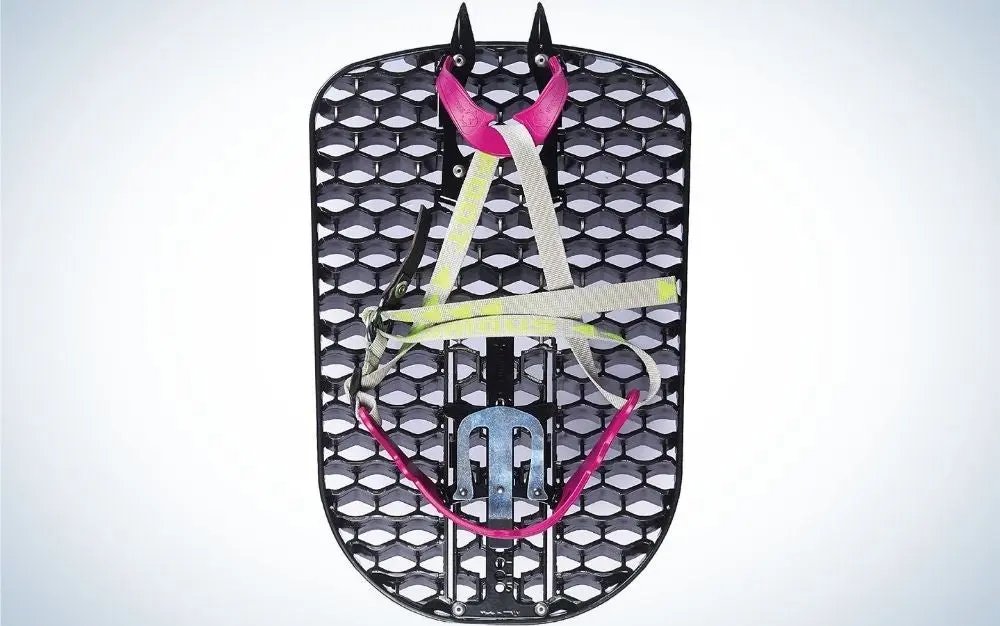
Snowfoot Snowshoes Snowfoot
Why It Made the Cut: Small and light but with crampons to climb glaciers, these unique snowshoes are what you need when climbing a slope.
Key Features
Weight per pair: 2 lbs 9 oz
Length: 14.5 inches
Materials: Composite
Pros
Light
Small
Excellent traction
Cons
Poor flotation
Snowfoots are new to the market and will make you take a second look. These odd-looking snowshoes are not much more than a foot long and the decking is made of hexagonal composite. Does snow pass through the holes? Yes, but due to the lightweight deck (only a pound each), it’s easily cleared. While the lack of overall floatation was poor in powder, it’s floatation was relatively good in my tests in wet, sticky snow—performing almost as good as the MSR Evos. I would recommend pairing these with a pair of mountaineering gaiters
if you plan to traverse areas with fresh snow. This way, you will have solid traction, but not kick snow up in your boots.
One of the benefits to this snowshoe is that the simple strap binding will accommodate everything from a ski boot to a hiking boot. This makes it a great option for alpinists climbing a peak to ski or snowboard down. Two sizable mountaineering crampons are attached to the front decking to allow the climber to ascend vertically on ice, with small traction teeth on the bottom.
I was surprisingly wooed by these unique snowshoes. While they are intended for mountaineering, I also found them fun and easy to use as a trail snowshoe. They are perfect for someone in need of an emergency snowshoe for their pack, a suitable traction device for climbing steep peaks, or a backcountry ski companion. This is the best snowshoe for alpinists.
Things to Consider Before Buying The Best Snowshoes
Modern snowshoes come in a variety of sizes, materials, and available features. Understanding these options will help you make the best choice on the type of snowshoe you need. Start with these basic considerations.
Activity
Do you want to go snowshoeing on a quiet nature trail or are you planning a mountain ascent? Will you be hiking in the backcountry with a large pack or are you going for a run on groomed trails? Whatever your primary snowy activity is, there’s a snowshoe to match. Here’s a breakdown of the best snowshoe types by activity:
Recreational Snowshoeing: This includes trail hiking, flat and rolling hills, and casual walks through snow. Snowshoes in this category should be light, comfortable, and have basic traction. Since there are very few technical or specific needs in recreational snowshoeing, snowshoes in this category tend to be more affordable. Examples include MSR Evo Trail, MSR Revo Trail, and Redfeather Snowshoes.
Technical Snowshoeing: This includes mountaineering and backcountry exploring. A technical snowshoe will often be able to fit mountaineering and/or ski boots, have more crampons and traction, and be able to accommodate more weight for those carrying packs and skis. Technical snowshoes tend to be pricier due to the additional features and high quality materials. Examples include MSR Lightning Ascent, Tubbs Mountaineer, and the featured TSL Hyperflex snowshoes.
Fitness Snowshoeing: In recent years, there has been an increase in the desire for snowshoes that users can run in. Fitness or running snowshoes accommodate racers with lightweight, minimalist designs, and can attach to running shoes. Examples include TSL Symbioz Racing Snowshoe, Atlas Run, and Yukon Charlie’s Run Ultralight snowshoes.
Materials
Modern snowshoes come in three main styles based on materials they are made of—aluminum, composite, and foam. Look how these styles are different when considering the best snowshoe for you.
Aluminum Frame: This is the most common type of snowshoe. An aluminum tubing creates a frame with a poly or cloth material stretched over it. This “deck” provides a lightweight yet strong surface area to prevent sinking into snow. Aluminum framed snowshoes come in a variety of sizes categorized by length. Snowshoes with larger surface areas will be heavier but have better floatation and can accommodate heavier loads.
Composite: Instead of aluminum tubing, composite snowshoes have decks that are made of solid plastic. These tend to be lighter and sturdy but can be loud when they flap against packed snow and sometimes less flexible.
Foam: The newest technology in snowshoes involves Crescent Moon’s introduction of EVA foam snowshoes. The benefits to foam are quiet walking, no moving parts, and it allows a more natural gate to your snowshoeing. These are great for groomed trails and running, but struggle to compete in deep snow or ice.
FAQs
Q: How much do snowshoes cost?
Snowshoes can cost as low as $50 and as much as $350. The cheapest snowshoes are often made with lower quality materials and as a result, are less comfortable and more prone to breaking. High quality snowshoes are comfortable, durable, and higher quality. If you are looking for a quality general recreational snowshoe, these can be found in the $150 range like the MSR Evo, Crescent Moon Eva, and Stoic Snowshoes.
Q: What brand of snowshoes are best?
The best brand of snowshoes is subjective. Just like your preference in sneakers might be different to a friend, similarly, some people prefer one brand to another. Leaders in the industry include but are not limited to MSR, Tubbs, TSL, Atlas, and Crescent Moon.
Q: Should I get 21 or 25 inch snowshoes?
The 21- and 25-inch snowshoes refer to the length of the deck. If a manufacturer is offering a snowshoe in these sizes, they should also have some sort of size chart to help you. The larger snowshoes can provide more floatation on top of the snow so in general, lighter people will use shorter snowshoes. Generally speaking, for a traditional aluminum snowshoe, 21 inches would be able to handle a max load of 180 lbs, while 25 inches could hold up to 220 lbs. Check with the manufacturer for the best specs.
Q: What snowshoes are good for beginners?
Snowshoes that are good for beginners should be comfortable, easy to attach, and fit a variety of footwear. Some great beginner snowshoes included the Crescent Moon Eva Foam (featured above), MSR Evo and Revo Trail snowshoes, and Atlas Helium Trail Snowshoes.
Q: What snowshoe size should I get?
Snowshoes are usually sized by length. The longer the snowshoe, the more surface area it has and therefore the more weight it can handle. Check the manufacturer’s size chart for the best length based on your max weight, and don’t forget to factor in the weight you will carry in a pack. Lastly, think about what kind of boot or shoe you will wear then make sure the binding can accommodate it. Most snowshoes are built to fit a winter hiking boot or semi-rigid snow boot, but many can handle everything from a running sneaker to a ski boot.
Final Thoughts on the Best Snowshoes
Snowshoeing builds strength, provides cardio, and allows us to enjoy fresh air and beautiful scenery in winter. Whether you’re looking to explore local woods after a fresh snow, scale a mountain, or play in the yard with your kids—there’s the best snowshoe for you.
Why Trust Us
For more than 125 years, Field & Stream has been providing readers with honest and authentic coverage of outdoor gear. Our writers and editors eat, sleep, and breathe the outdoors, and that passion comes through in our product reviews. You can count on F&S to keep you up to date on the best new gear. And when we write about a product—whether it’s a bass lure or a backpack—we cover the good and the bad, so you know exactly what to expect before you decide to make a purchase.






